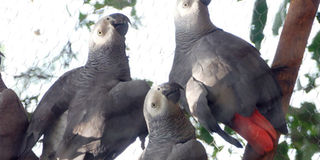Flying away to freedom

The parrots just before they were released into the wild. Photo by Edgar R. Batte.
What you need to know:
The endangered African grey parrot boasts of such high intelligence levels that it is a favourite of poachers. However recently over two hundred of the beautiful birds were released back to the wild, writes Edgar R. Batte
The African grey parrot is a beautiful, intelligent and unique creation. But for these attributes and more, this parrot is one of the most sought-after for its social nature and high intelligence.
Last week, 204 formerly confiscated African grey parrots flew into the wild from domestication by Uganda Wildlife Authority (UWA). These popular beauties had been impounded from poachers at the Mpondwe customs border post in Kasese and at a private farm at Kawuku along the Kampala-Entebbe highway. The poachers were preparing to sell them across the borders.
For the grey-feathered birds, it was a while in captivity and this was time to start a new life. For many, one of a long-term relationship as couples in the wild at Kibaale National Park, a new found home in the natural.
Social partners
This will not be complete freedom though as UWA’s Public Relations Officer (PRO) Lillian Nsubuga says poachers will be coming after them. Every one of us would like a social partner and in the West, these parrots are popular partners and as such Nsubuga explained that many people have made this their lucrative source of livelihood.
Johnson Maseruka, UWA’s community conservation coordinator says that the demand for African grey parrots is very high in the world market where a parrot can fetch up to US$2,000. Experts regard this type of parrot to be one of the most intelligent birds, which is the sole reason they are a target for pet trade and poachers.
A recent analysis suggests that up to 21 per cent of the global population may be taken from the wild annually, primarily for pet trade. Nonetheless, it was quite a sight as these grey gems flew onto tree branches in the thick-forested Kibaale National Park after a six-month quarantine period at the Uganda Wildlife Education Centre (UWEC).
“We would like to embark on an awareness campaign to sensitise police and immigration on currently endangered species in Uganda,” Masereka adds.
UWA will not be making it easy for poachers though. It has trained personnel to handle the birds and promised to organise field inspection of all sites. But at their release, being recaptured into domesticated environs was the last thing on these mid-sized birds.
Freedom
Cries transformed into whistle, shrieking and squeaking as they flapped their wings into the free. A few failed to make it and Dr Noel Arinteireho, a veterinarian who has been taking care of these birds at UWEC, took them back into their cages for special treatment. He says that a parrot can live up to 70 years in captivity though a shorter life in the wild. “The male parrot has darker feathers and like other birds or animals has a defence mechanism. It uses its beak in self-defence and when it pecks you hard it can easily peck off your finger. They use tree logs for resting while in the wild,” Dr Arinteireho adds.
Gerald Tumwekwase, a private range guide at Kibaale National Park says one can also find the more common brown parrot in this park. He adds that when parrots make noise, it is not to irritate but is a way these species communicate among themselves.
The parrots love feeding on palm nuts, seeds, fruits, leafy matter, snails and can get irritated just like you. Though when well-kept,they are fun company, capitalising on mimicking you and could be your domestic watch birds. Maseruka adds that the African grey parrot can master up to 1,000 words.




